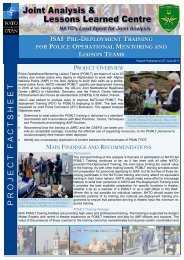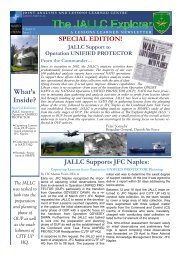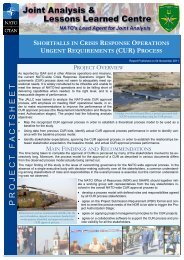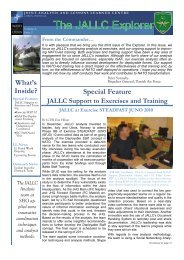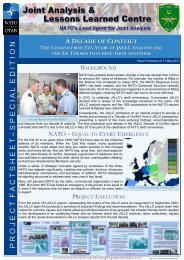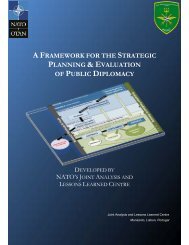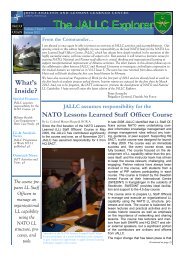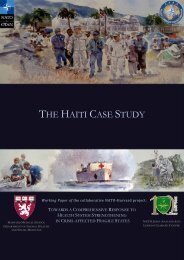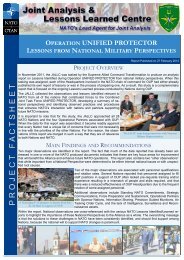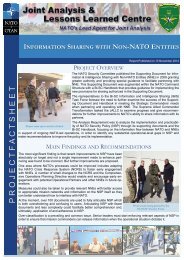4.3.4 Information and <strong>in</strong>telligenceOw<strong>in</strong>g to the complexity of the environment, the success of the mission <strong>in</strong>Uruzgan was particularly dependent on strong <strong>in</strong>telligence. Big steps weretaken <strong>in</strong> improv<strong>in</strong>g the <strong>in</strong>telligence organisation. NATO’s Jo<strong>in</strong>t Collection andFusion Concept was <strong>in</strong>troduced with<strong>in</strong> the TFU. In the context of thisconcept, various Defence <strong>in</strong>telligence entities work together <strong>in</strong> the area ofoperations. All relevant <strong>in</strong>formation was brought together and targetedquestions could be sent to relevant parties without first hav<strong>in</strong>g to gothrough senior echelons <strong>in</strong> the <strong>Netherlands</strong>. The tasks and authorisations ofthe Defence Intelligence and Security Service (DISS), which are subject tothe Intelligence and Security Services Act, formed an exception to thismode of work<strong>in</strong>g.The DISS made a major effort <strong>in</strong> support<strong>in</strong>g commanders <strong>in</strong> the area ofoperations and decision-makers <strong>in</strong> The Hague right from the very beg<strong>in</strong>n<strong>in</strong>gof the mission. In addition to a National Intelligence Cell <strong>in</strong> Kabul, the DISSset up two National Intelligence Support Teams (NISTs), based <strong>in</strong> Kandaharand Tar<strong>in</strong> Kowt. The NISTs <strong>in</strong> Uruzgan were largely <strong>in</strong>tegrated with the TFU<strong>in</strong>telligence cell <strong>in</strong> Tar<strong>in</strong> Kowt. In The Hague, the DISS set up a large-scaleAfghanistan Team <strong>in</strong> support of the mission. By gather<strong>in</strong>g both local andnational <strong>in</strong>formation, and by <strong>in</strong>tensive cooperation and exchange of<strong>in</strong>formation with various <strong>ISAF</strong> partners active with<strong>in</strong> RC-S, the DISS wascapable of generat<strong>in</strong>g high-quality <strong>in</strong>formation about the situation <strong>in</strong>Uruzgan. This <strong>in</strong>formation was, <strong>in</strong> strategic and tactical terms, of greatvalue for the execution of the mission and for the security of Dutch militaryand civilian personnel. The DISS also deployed additional personnel andresources <strong>in</strong> support of the operations of special forces.Information on the situation outside the <strong>in</strong>k blot was highly important forsecurity with<strong>in</strong> the <strong>in</strong>k blot. The activities of the <strong>in</strong>surgents could only beanticipated by hold<strong>in</strong>g and ma<strong>in</strong>ta<strong>in</strong><strong>in</strong>g a good <strong>in</strong>formation position. Specialforces were deployed for this purpose.4.3.5 Special forces <strong>in</strong> UruzganFrom <strong>2006</strong>, Dutch special forces (from the Commando Corps (KCT) and theMar<strong>in</strong>e Corps) operated <strong>in</strong> Afghanistan dur<strong>in</strong>g two separate periods.Between April <strong>2006</strong> and December 2007, a Special Operations Task Group(Task Force Viper) took part <strong>in</strong> <strong>ISAF</strong> operations, <strong>in</strong>itially as part of theDeployment Task Force (DTF) and subsequently as part of the TFU. Over ayear later, a Dutch special unit (Task Force 55) was deployed for a secondtime, from April 2009 up to and <strong>in</strong>clud<strong>in</strong>g August <strong>2010</strong>.Task Force Viper was primarily deployed as a reconnaissance unit. Bygather<strong>in</strong>g <strong>in</strong>telligence and acquir<strong>in</strong>g and reta<strong>in</strong><strong>in</strong>g situational awareness,Viper made an important contribution to the missions of both the DTF andthe TFU. In addition, Viper supported various TFU operations by, amongother th<strong>in</strong>gs, act<strong>in</strong>g as a Quick Reaction Force and as a convoy protectionunit. Viper’s assignments were particularly focused on the boundaries of theTFU’s area of responsibility, where regular units were hardly active if at all.Task Force 55 (TF-55) was a special unit, consist<strong>in</strong>g of elements of theCommando Corps and the Mar<strong>in</strong>e Corps, with support elements. Its taskscomprised carry<strong>in</strong>g out reconnaissance, gather<strong>in</strong>g <strong>in</strong>telligence, disrupt<strong>in</strong>g<strong>in</strong>surgency activity outside the <strong>in</strong>k blot, detect<strong>in</strong>g <strong>in</strong>surgents plann<strong>in</strong>g tocarry out attacks, and tra<strong>in</strong><strong>in</strong>g and mentor<strong>in</strong>g an Afghan partner unit. Theunit was stationed at the base <strong>in</strong> Tar<strong>in</strong> Kowt, but was not under commandof the TFU. The operations of TF-55 were carried out <strong>in</strong> cooperation with thePage 36 of 133
Afghan partner unit, at all times only after explicit permission from the NLDCHOD. These operations stood <strong>in</strong> direct relation to the activities and missionof the TFU <strong>in</strong> Uruzgan.TF-55 was supported <strong>in</strong> each mission by so-called enablers, such ashelicopters, eng<strong>in</strong>eers, fire support (mortars), Explosive Ordnance Disposal(EOD) units and capabilities for electronic warfare (EW). TF-55 did not haveits own enablers. The unit consequently had to rely on the TFU and RC-S forenabler capabilities.4.3.6 The <strong>in</strong>k blot strategy <strong>in</strong> practiceBefore the handover to <strong>ISAF</strong> <strong>in</strong> <strong>2006</strong>, OEF coalition troops <strong>in</strong> Uruzgan hadfour bases, two near the population centres <strong>in</strong> the south of the prov<strong>in</strong>ce, atTar<strong>in</strong> Kowt and Deh Rawod, and two at a more northerly location <strong>in</strong> theprov<strong>in</strong>ce. The Article 100 letter of 2005 conta<strong>in</strong>ed the follow<strong>in</strong>g passage:“In view of the size of the units made available for the mission, the taskforce will, for the time be<strong>in</strong>g, not occupy all four of the current baseslocated <strong>in</strong> Uruzgan. The Dutch area of deployment will rema<strong>in</strong> restricted tothe southern part of the prov<strong>in</strong>ce of Uruzgan”.Initially, the ADZ <strong>in</strong> Uruzgan encompassed solely the population centres ofDeh Rawod and Tar<strong>in</strong> Kowt. In order for the <strong>in</strong>k blot to expand, smallerposts (Forward Operat<strong>in</strong>g Bases and Patrol Bases) were established <strong>in</strong> theperiphery of the <strong>in</strong>k blot.Consequently, <strong>in</strong> a large area of Uruzgan there was no Dutch militarypresence. In the districts of Chahar Ch<strong>in</strong>eh and Khas Uruzgan, Americanspecial forces were active, while Australian special forces were operat<strong>in</strong>g <strong>in</strong>central Uruzgan.Activities related to socio-economic development were not restricted to theADZ. Disadvantaged tribes, who often supported the Taliban, also had theirsettlements outside the ADZ. They were actively approached <strong>in</strong> order toimprove their socio-economic situation by means of development projects,thus reduc<strong>in</strong>g their support for the Taliban. In this context, among theactivities carried out were the build<strong>in</strong>g of bridges and renovation of waterchannels <strong>in</strong> the Gizab district.The <strong>ISAF</strong> strategy of the four separate operational phases (Shape, Clear,Hold and Build), described earlier, was not carried out strictly accord<strong>in</strong>g tothe concept. In practice, a strict separation between the separate phases(both <strong>in</strong> time and space) was not possible to achieve. At certa<strong>in</strong> times,different parts of Uruzgan were <strong>in</strong> different phases of the concept. Whereasthe Shape phase was <strong>in</strong>itially solely focused on aspects of the militaryoperation, activities carried out <strong>in</strong> this phase became, more than waspreviously the case, focused on the needs of the local people, br<strong>in</strong>g<strong>in</strong>g thisphase more <strong>in</strong> l<strong>in</strong>e with the follow<strong>in</strong>g phases. The same can be said for theother phases. Eventually, operations were prepared (Shape) <strong>in</strong> such a waythat after the operation (Clear) had taken place, security could beguaranteed (Hold) and reconstruction projects could be started (Build). The<strong>in</strong>tegration of these different elements became more pronounced as themission progressed, which benefited the effectiveness of specificoperations. The necessity of repeat operations <strong>in</strong> the Baluchi Valleyhighlighted the importance of an <strong>in</strong>tegrated approach.Page 37 of 133
- Page 1 and 2: Final evaluationNetherlands contrib
- Page 3 and 4: High mountainsLow mountainsPlains a
- Page 5 and 6: Table of ContentsDutch military per
- Page 7 and 8: Dutch military personnel deceased i
- Page 9 and 10: Page 9 of 133
- Page 11 and 12: 1 IntroductionThe government would,
- Page 13 and 14: The structure of the final evaluati
- Page 15 and 16: 2 The international presence in Afg
- Page 17 and 18: insurgents in, particularly, the ea
- Page 19 and 20: 3 Netherlands policy for participat
- Page 21 and 22: Netherlands’ presence. Furthermor
- Page 23 and 24: “The objectives of this stabilisa
- Page 25 and 26: In December 2005, the Netherlands g
- Page 27 and 28: The expectation is that meaningful
- Page 29 and 30: 3.6.2 Implementation of national pr
- Page 31 and 32: 4 Implementation of the mission and
- Page 33 and 34: tasks to fulfil in the area of secu
- Page 35: such as the Bushmaster, that was be
- Page 39 and 40: northern part of Deh Rawod in 2007.
- Page 41 and 42: in large and small bases, while con
- Page 43 and 44: previously thought and comprised a
- Page 45 and 46: Apart from facilitating training an
- Page 47 and 48: If operations in close proximity of
- Page 49 and 50: As previously mentioned, the preven
- Page 51 and 52: - Between 2006 and 2010, the number
- Page 53 and 54: government of Chora in January 2010
- Page 55 and 56: At the beginning of the Dutch missi
- Page 57 and 58: intermediary of TLO and political a
- Page 59 and 60: interest for filling judicial posit
- Page 61 and 62: During the Uruzgan mission, a great
- Page 63 and 64: structurally change governance in U
- Page 65 and 66: development programmes. Before the
- Page 67 and 68: also the way in which Afghans perce
- Page 69 and 70: tailored to the real needs of the p
- Page 71 and 72: Gizab had increased and there was a
- Page 73 and 74: The DCU programme devoted and still
- Page 75 and 76: purpose of these loans, cooperative
- Page 77 and 78: In view of the lack of enthusiasm a
- Page 79 and 80: 5 Expenditure for the mission and i
- Page 81 and 82: Overview of long-term expenditure a
- Page 83 and 84: expenditure related to the deployme
- Page 85 and 86: Multi-year expenditure, Foreign Aff
- Page 87 and 88:
explosive ordnance disposal, armour
- Page 89 and 90:
this situation as constraining, for
- Page 91 and 92:
organised at a later stage. In addi
- Page 93 and 94:
occupational social workers and the
- Page 95 and 96:
Mercedes Benz terrain vehicle, the
- Page 97 and 98:
6 ConclusionsThis chapter begins wi
- Page 99 and 100:
The first part of the central quest
- Page 101 and 102:
At the end of 2005, the Afghan auth
- Page 103 and 104:
province. This, too, was done by me
- Page 105 and 106:
area, increased sales of agricultur
- Page 107 and 108:
ISAF and the OEF led to extra coord
- Page 109 and 110:
d. The recommendations from advisor
- Page 111 and 112:
Page 111 of 133
- Page 113 and 114:
Annex A, Afghanistan Compact Benchm
- Page 115 and 116:
end-2010, reforms will strengthen t
- Page 117 and 118:
Afghan Cultural HeritageA comprehen
- Page 119 and 120:
Private Sector Development and Trad
- Page 121 and 122:
Annex B, Results of the socio-econo
- Page 123 and 124:
EducationTLO data:• In 2006 there
- Page 125 and 126:
Overview of the number of children
- Page 127 and 128:
Annex C, Chronology200522 December:
- Page 129 and 130:
July: microcredit provider World Co
- Page 131 and 132:
Annex D, List of abbreviations3DADZ
- Page 133:
Page 133 of 133




